Pollution Assessment Using Soil and Plant Leaves in Faisalabad, Pakistan
Abstract
1. Introduction
2. Materials and Methods
2.1. Sample Areas
2.2. Sample Species and Collection
2.3. Soil Parameter Analysis
2.4. Elemental Analysis of Soil and Leaves
2.5. Bioaccumulation Factor Analysis (BAF)
2.6. Statistical Analysis
3. Results
3.1. Physico-Chemical Properties of Soil
3.2. Elemental Concentration in A. indica Leaves
3.3. Bio-Accumulation Factor (BAF)
4. Discussion
5. Conclusions
Author Contributions
Funding
Institutional Review Board Statement
Informed Consent Statement
Data Availability Statement
Conflicts of Interest
References
- Toccalino, P.L.; Norman, J.E. Health–Based Screening Levels to Evaluate US Geological Survey Groundwater Quality Data. Risk Anal. 2006, 26, 1339–1348. [Google Scholar] [CrossRef] [PubMed]
- Doran, J.W.; Sarrantonio, M.; Liebig, M.A. Soil Health and Sustainability. Adv. Agron. 1996, 56, 10. [Google Scholar]
- Okrent, D. David Okrent On Intergenerational Equity and Its Clash with Intragenerational Equity and on the Need for Policies to Guide the Regulation of Disposal of Wastes and Other Activities Posing Very Long-Term Risks. Risk Anal. 1999, 19, 877–901. [Google Scholar] [CrossRef]
- Liu, C.; Zhang, Y.; Zhang, F. Assessing Pollutions of Soil and Plant by Municipal Waste Dump. Env. Geol 2007, 52, 641–651. [Google Scholar] [CrossRef]
- Anwar, M.N.; Shabbir, M.; Tahir, E.; Iftikhar, M.; Saif, H.; Tahir, A.; Murtaza, M.A.; Khokhar, M.F.; Rehan, M.; Aghbashlo, M.; et al. Emerging Challenges of Air Pollution and Particulate Matter in China, India, and Pakistan and Mitigating Solutions. J. Hazard. Mater. 2021, 416, 125851. [Google Scholar] [CrossRef] [PubMed]
- Nisar, H.; Ejaz, N.; Naushad, Z.; Ali, Z. Impacts of Solid Waste Management in Pakistan: A Case Study of Rawalpindi City. WIT Trans. Ecol. Environ. 2008, 109, 685–691. [Google Scholar]
- Rashida Haq, R.H.; Ahmed, A.; Shafique, S. Variation in the Quality of Life within Punjab: Evidence from MICS, 2007–2008. Pakistan Dev. Rev. 2010, 9, 863. [Google Scholar]
- Qadeer, M.A. Do’s and Don’ts of Urban Policies in Pakistan. In Pakistan’s Runaway Urbanization: What Can Be Done? The Wilson Center: Washington, DC, USA, 2014; ISBN 978-1-938027-39-0. [Google Scholar]
- Javed, N.; Qureshi, N.N. City Profile: Faisalabad, Pakistan. Environ. Urban. ASIA 2019, 10, 233–254. [Google Scholar] [CrossRef]
- Mukherjee, A.; Agrawal, S.B.; Agrawal, M. Heavy Metal Accumulation Potential and Tolerance in Tree and Grass Species. In Plant Responses to Xenobiotics; Springer: Singapore, 2016; pp. 177–210. [Google Scholar]
- Opydo, J.; Ufnalski, K.; Opydo, W. Heavy Metals in Polish Forest Stands of Quercus Robur and Q. Petraea. Water, Air, Soil Pollut. 2005, 161, 175–192. [Google Scholar] [CrossRef]
- Molnár, V.É.; Simon, E.; Ninsawat, S.; Tóthmérész, B.; Szabó, S. Pollution Assessment Based on Element Concentration of Tree Leaves and Topsoil in Ayutthaya Province, Thailand. Int. J. Environ. Res. Public Health 2020, 17, 5165. [Google Scholar] [CrossRef]
- De Sá, J.P.M. Applied Statistics Using SPSS, Statistica, MatLab and R, 2nd ed.; Springer: Berlin/Heidelberg, Germany, 2007; ISBN 978-3-540-71971-7. [Google Scholar]
- Clinton, P.; Owens, J. Structure and Function of Forested Soils. In Encyclopedia of Soils in the Environment; Elsevier: Amsterdam, The Netherlands, 2023; pp. 56–67. [Google Scholar]
- Biernbaum, J. Organic Matters: Feeding the Soil and Building Soil Quality. Available online: https://www.canr.msu.edu/hrt/uploads/535/78622/Organic-Matters-figure-6pgs.pdf (accessed on 27 March 2025).
- Asabere, S.B.; Zeppenfeld, T.; Nketia, K.A.; Sauer, D. Urbanization Leads to Increases in PH, Carbonate, and Soil Organic Matter Stocks of Arable Soils of Kumasi, Ghana (West Africa). Front. Environ. Sci. 2018, 6, 119. [Google Scholar] [CrossRef]
- Kumar, Y.; Kumar, S. Azadirachta Indica Leafs Absorbs Heavy Metal (Lead). Int. J. Chem. Stud. 2022, 10, 86–89. [Google Scholar]
- Naithani, V.; Pathak, N.; Chaudhary, M. Evaluation of Heavy Metals in Two Major Ingredients of Ampucare. Int. J. Pharm. Sci. Drug Res. 2010, 2, 137–141. [Google Scholar] [CrossRef]
- Patel, K.S.; Sharma, R.; Dahariya, N.S.; Yadav, A.; Blazhev, B.; Matini, L.; Hoinkis, J. Heavy Metal Contamination of Tree Leaves. Am. J. Anal. Chem. 2015, 6, 687–693. [Google Scholar] [CrossRef][Green Version]
- Waseem, A.; Arshad, J.; Iqbal, F.; Sajjad, A.; Mehmood, Z.; Murtaza, G. Pollution Status of Pakistan: A Retrospective Review on Heavy Metal Contamination of Water, Soil, and Vegetables. Biomed. Res. Int. 2014, 2014, 813206. [Google Scholar] [CrossRef]
- Zając, G.; Szyszlak-Bargłowicz, J.; Słowik, T.; Kuranc, A.; Kamińska, A. Designation of Chosen Heavy Metals in Used Engine Oils Using the XRF Method. Polish J. Environ. Stud. 2015, 24, 2277–2283. [Google Scholar] [CrossRef]
- Wang, Y.-F.; Huang, K.-L.; Li, C.-T.; Mi, H.-H.; Luo, J.-H.; Tsai, P.-J. Emissions of Fuel Metals Content from a Diesel Vehicle Engine. Atmos. Environ. 2003, 37, 4637–4643. [Google Scholar] [CrossRef]
- Filipiak-Szok, A.; Kurzawa, M.; Szłyk, E. Determination of Toxic Metals by ICP-MS in Asiatic and European Medicinal Plants and Dietary Supplements. J. Trace Elem. Med. Biol. 2015, 30, 54–58. [Google Scholar] [CrossRef]
- Faiz, Y.; Tufail, M.; Javed, M.T.; Chaudhry, M.M. Naila-Siddique Road Dust Pollution of Cd, Cu, Ni, Pb and Zn along Islamabad Expressway, Pakistan. Microchem. J. 2009, 92, 186–192. [Google Scholar] [CrossRef]
- Nawaz, A.L.L.A.H.; Khurshid, K.A.S.H.I.F.; Arif, M.S.; Ranjha, A.M. Accumulation of Heavy Metals in Soil and Rice Plant (Oryza sativa L.) Irrigated with Industrial Effluents. Int. J. Agric. Biol. 2006, 8, 391–393. [Google Scholar]
- Pirzada, H.; Ahmad, S.S.; Rashid, A.; Shah, T. Multivariate Analysis of Selected Roadside Plants (Dalbergia Sissoo and Cannabis Sativa) for Lead Pollution Monitoring. Pak. J. Bot. 2009, 41, 1729–1736. [Google Scholar]
- Bibi, D.; Tőzsér, D.; Sipos, B.; Tóthmérész, B.; Simon, E. Heavy Metal Pollution of Soil in Vienna, Austria. Water Air Soil Pollut. 2023, 234, 232. [Google Scholar] [CrossRef]
- Ayaz, H.; Nawaz, R.; Nasim, I.; Irshad, M.A.; Irfan, A.; Khurshid, I.; Okla, M.K.; Wondmie, G.F.; Ahmed, Z.; Bourhia, M. Comprehensive Human Health Risk Assessment of Heavy Metal Contamination in Urban Soils: Insights from Selected Metropolitan Zones. Front. Environ. Sci. 2023, 11, 1260317. [Google Scholar] [CrossRef]
- Umer, S.; Hussain, M.; Arfan, M.; Rasul, F. Spatiotemporal Variations of Metals in Urban Roadside Soils and Ornamental Plant Species of Faisalabad Metropolitan, Pakistan. Int. J. Environ. Sci. Technol. 2022, 19, 6491–6498. [Google Scholar] [CrossRef]
- Rezapour, S.; Siavash Moghaddam, S.; Nouri, A.; Khosravi Aqdam, K. Urbanization Influences the Distribution, Enrichment, and Ecological Health Risk of Heavy Metals in Croplands. Sci. Rep. 2022, 12, 3868. [Google Scholar] [CrossRef]
- Wang, S.; Zhou, C.; Wang, Z.; Feng, K.; Hubacek, K. The Characteristics and Drivers of Fine Particulate Matter (PM2.5) Distribution in China. J. Clean. Prod. 2017, 142, 1800–1809. [Google Scholar] [CrossRef]
- Xie, T.; Wang, M.; Chen, W.; Uwizeyimana, H. Impacts of Urbanization and Landscape Patterns on the Accumulation of Heavy Metals in Soils in Residential Areas in Beijing. J. Soils Sediments 2019, 19, 148–158. [Google Scholar] [CrossRef]
- Madrid, L.; Díaz-Barrientos, E.; Madrid, F. Distribution of Heavy Metal Contents of Urban Soils in Parks of Seville. Chemosphere 2002, 49, 1301–1308. [Google Scholar] [CrossRef]
- Maas, S.; Scheifler, R.; Benslama, M.; Crini, N.; Lucot, E.; Brahmia, Z.; Benyacoub, S.; Giraudoux, P. Spatial Distribution of Heavy Metal Concentrations in Urban, Suburban and Agricultural Soils in a Mediterranean City of Algeria. Environ. Pollut. 2010, 158, 2294–2301. [Google Scholar] [CrossRef]
- Langner, A.N.; Manu, A.; Tabatabai, M.A. Heavy Metals Distribution in an Iowa Suburban Landscape. J. Environ. Qual. 2011, 40, 83–89. [Google Scholar] [CrossRef]
- Rodríguez-Eugenio, N.; McLaughlin, M.; Pennock, D. Soil Pollution: A Hidden Reality; FAO: Rome, Italy, 2018; ISBN 978-92-5-130505-8. [Google Scholar]
- Adamczyk-Szabela, D.; Wolf, W.M. The Impact of Soil PH on Heavy Metals Uptake and Photosynthesis Efficiency in Melissa Officinalis, Taraxacum Officinalis, Ocimum Basilicum. Molecules 2022, 27, 4671. [Google Scholar] [CrossRef] [PubMed]
- He, G.; Zhang, Z.; Wu, X.; Cui, M.; Zhang, J.; Huang, X. Adsorption of Heavy Metals on Soil Collected from Lixisol of Typical Karst Areas in the Presence of CaCO3 and Soil Clay and Their Competition Behavior. Sustainability 2020, 12, 7315. [Google Scholar] [CrossRef]
- Yan, A.; Wang, Y.; Tan, S.N.; Mohd Yusof, M.L.; Ghosh, S.; Chen, Z. Phytoremediation: A Promising Approach for Revegetation of Heavy Metal-Polluted Land. Front. Plant Sci. 2020, 11, 359. [Google Scholar] [CrossRef] [PubMed]
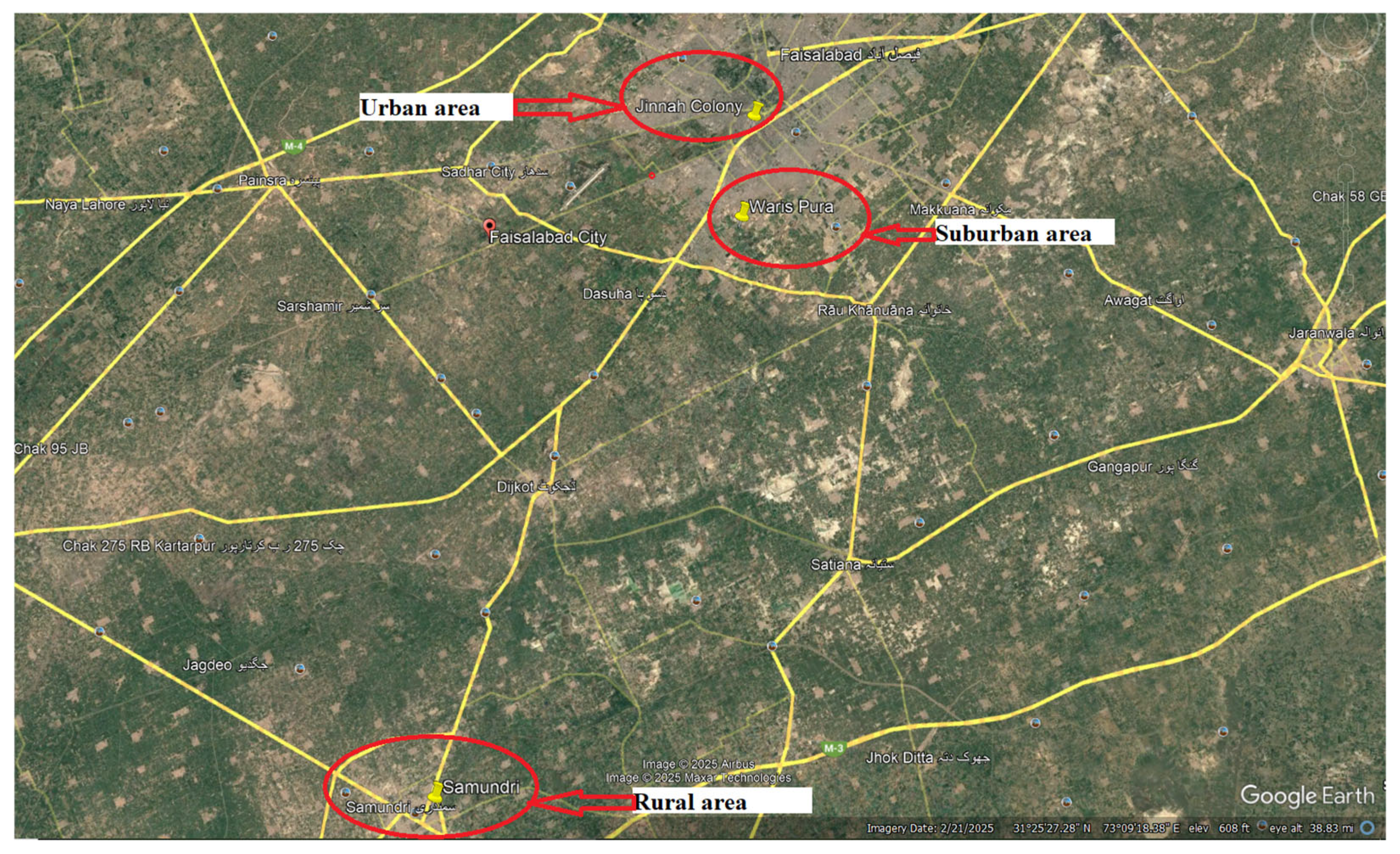
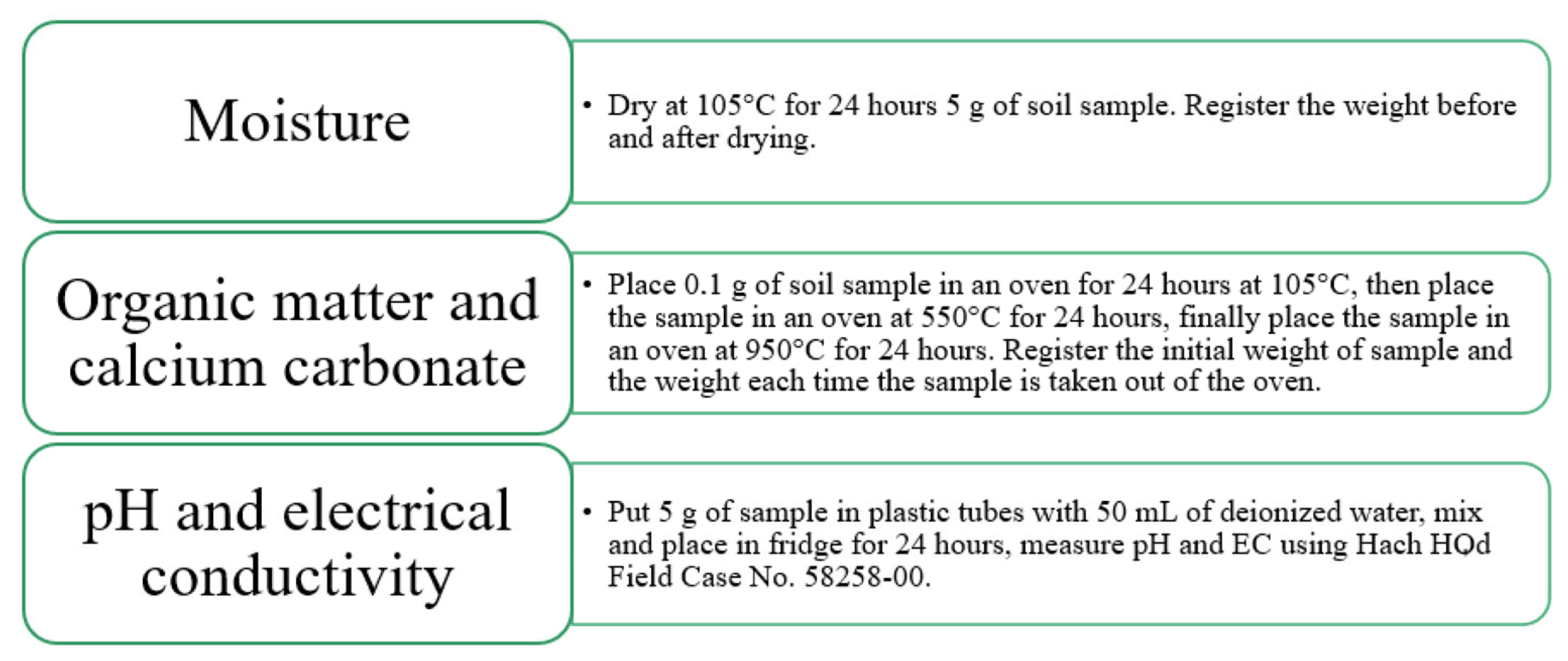
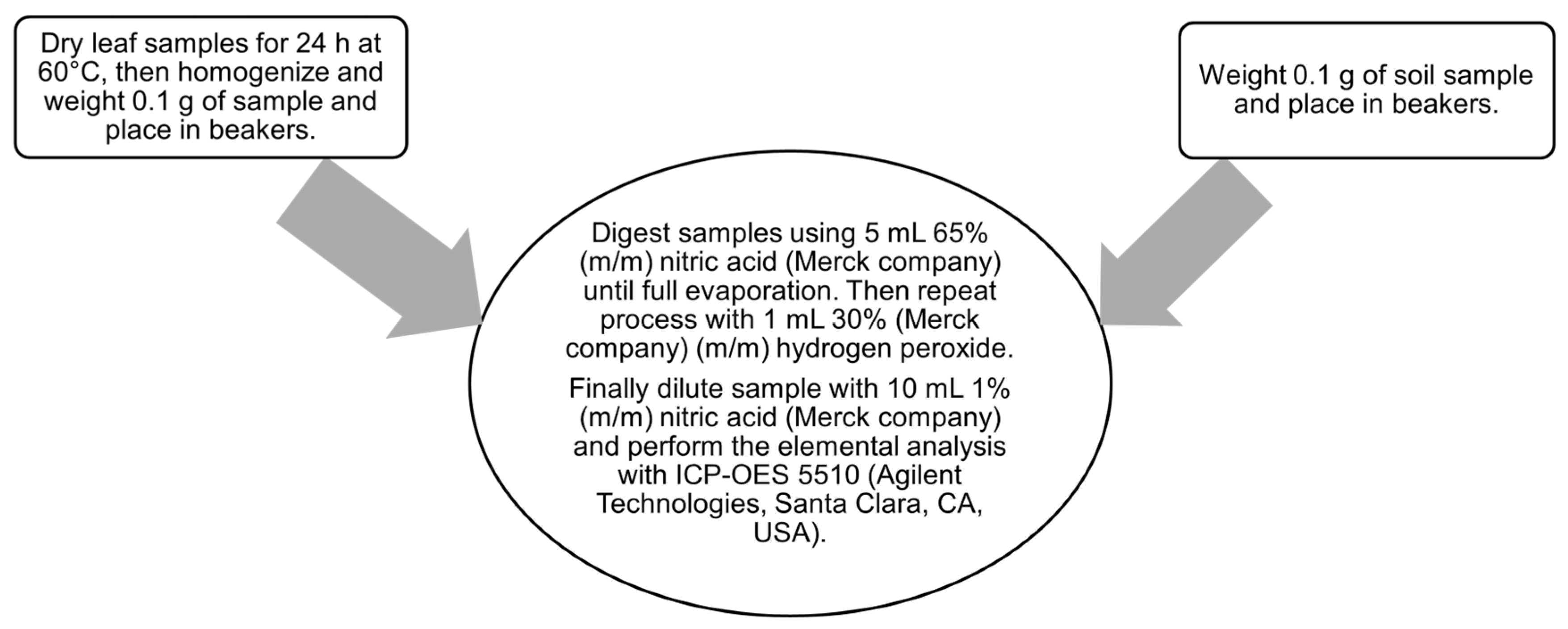
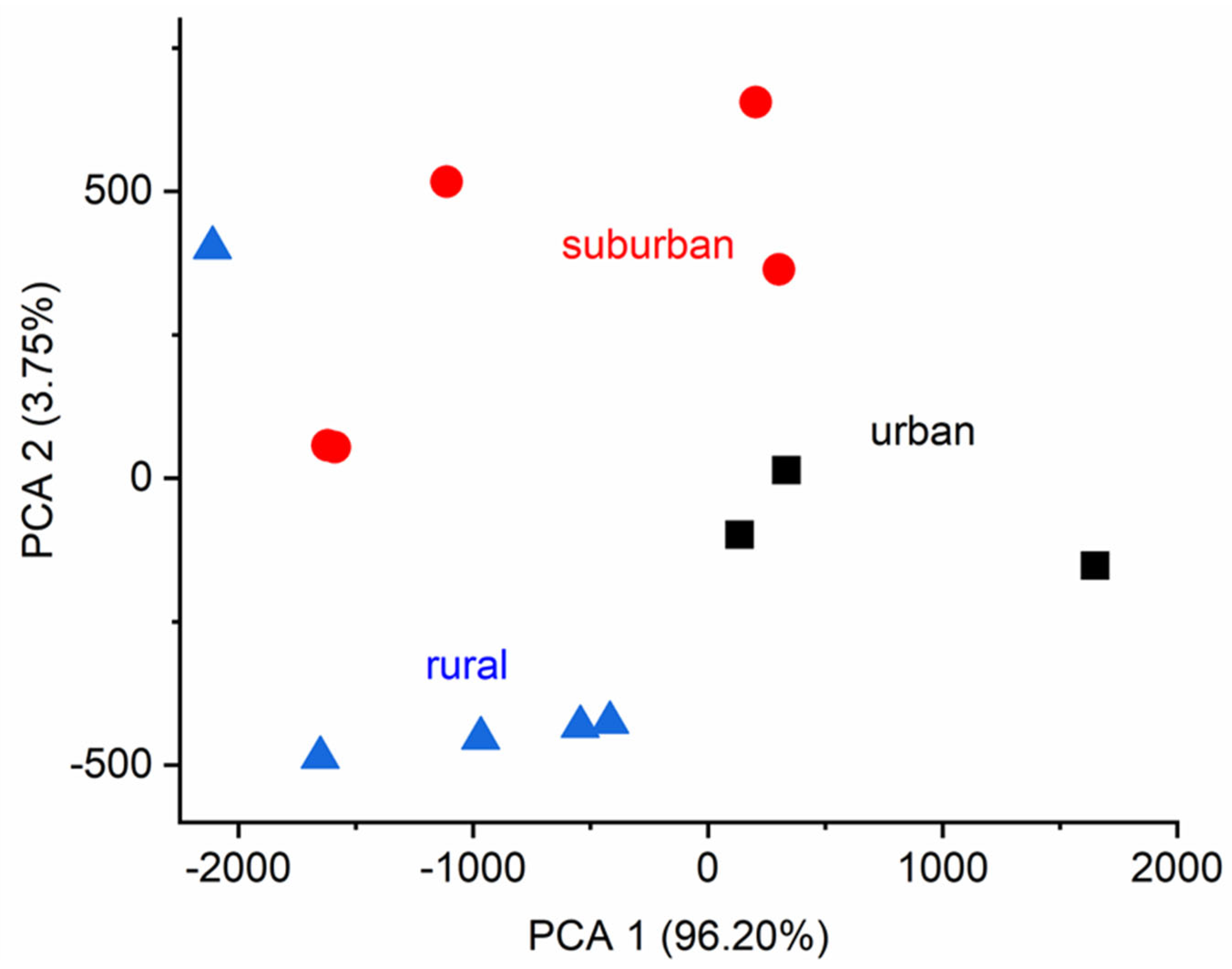
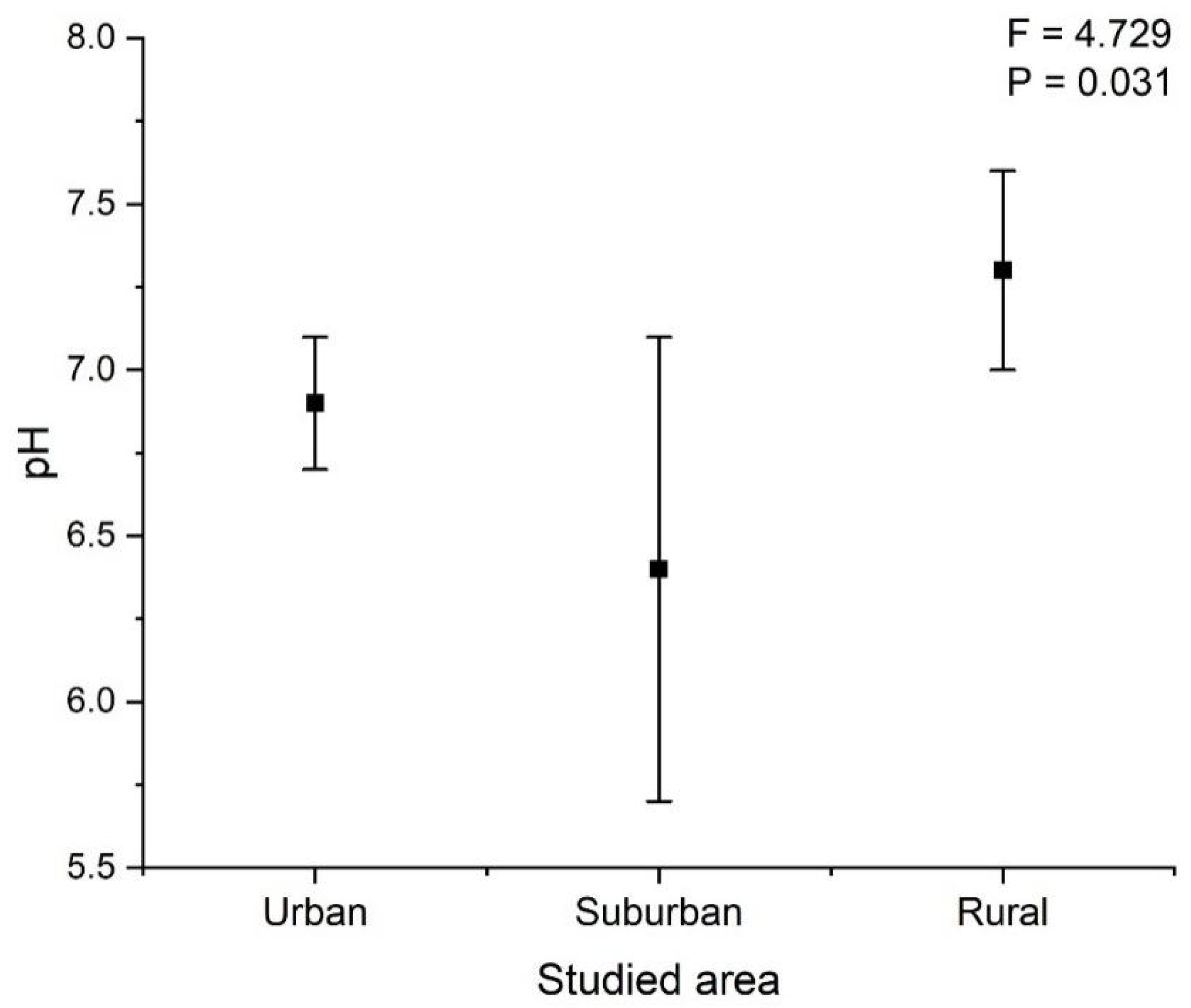
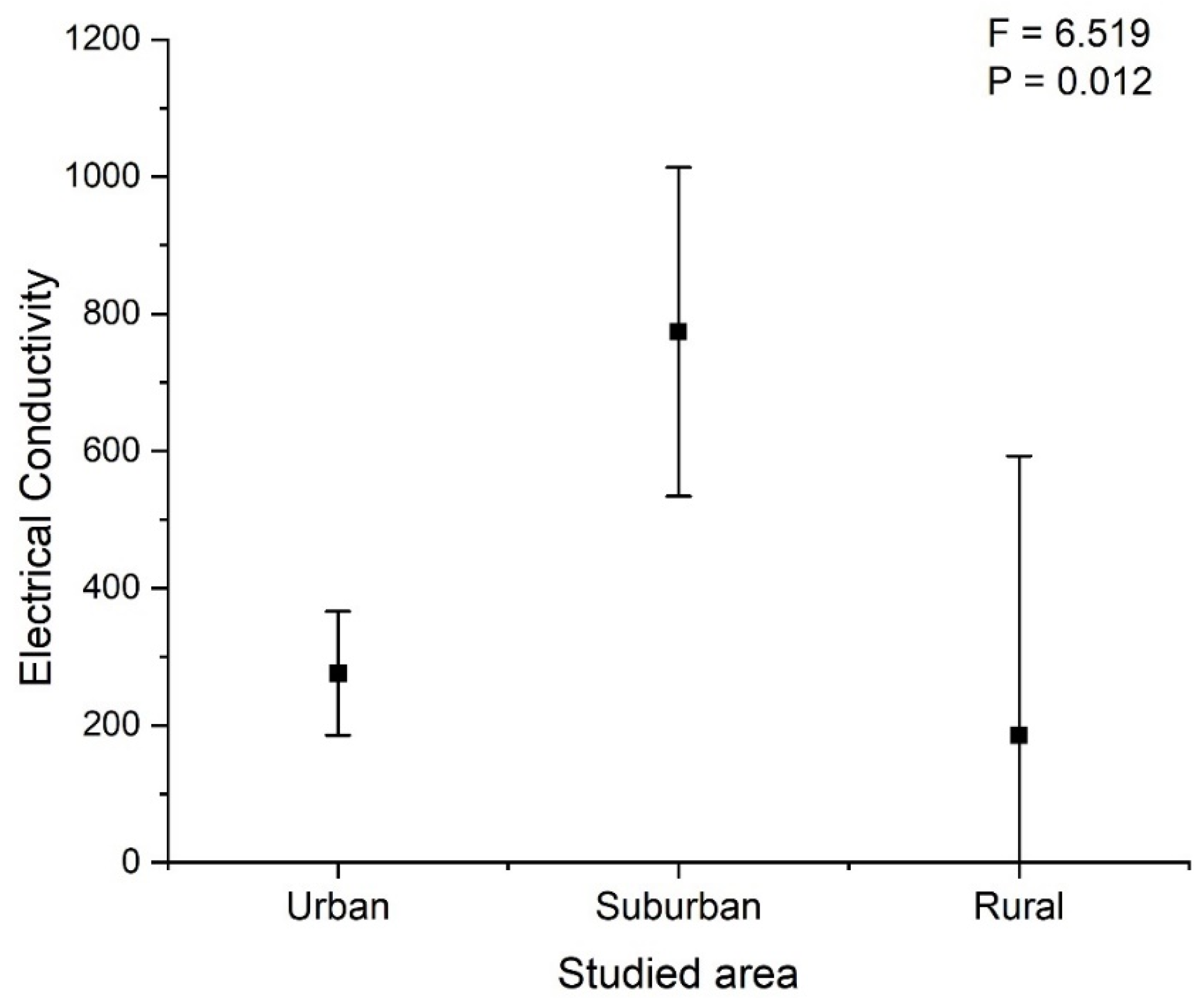

| Parameters | Studied Areas | Results of ANOVA | |||
|---|---|---|---|---|---|
| Urban | Suburban | Rural | F | p | |
| pH | 6.9 ± 0.2 | 6.4 ± 0.7 | 7.3 ± 0.3 | 4.729 | 0.031 |
| Electrical conductivity, μS cm−2 | 276 ± 91 | 774 ± 240 | 186 ± 407 | 6.519 | 0.012 |
| Moisture content, % | 4.0 ± 1.9 | 4.2 ± 2.3 | 14 ± 2 | 1.047 | 0.381 |
| Organic matter, % | 5.8 ± 1.4 | 4.5 ± 0.5 | 4.6 ± 0.8 | 2.955 | 0.900 |
| Calcium carbonate, % | 2.9 ± 0.4 | 3.4 ± 1.6 | 2.1 ± 0.6 | 1.920 | 0.189 |
| Elements | Studied Area | Results of ANOVA | |||
|---|---|---|---|---|---|
| Urban | Suburban | Rural | F | p | |
| Ba | 100 ± 4 | 74 ± 6 | 65 ± 4 | 72.340 | <0.001 |
| Co | 5.3 ± 0.4 | 3.9 ± 0.5 | 3.8 ± 0.3 | 21.717 | <0.001 |
| Cr | 15 ± 2 | 13 ± 1 | 11 ± 1 | 20.974 | <0.001 |
| Cu | 20 ± 2 | 14 ± 1 | 9.6 ± 1.0 | 47.248 | <0.001 |
| Fe | 13,559 ± 1864 | 10,927 ± 959 | 10,522 ± 714 | 8.321 | 0.005 |
| Mn | 616 ± 174 | 355 ± 27 | 370 ± 39 | 9.978 | 0.003 |
| Ni | 21 ± 3 | 17 ± 2 | 17 ± 1 | 9.463 | 0.003 |
| Pb | 26 ± 4 | 14 ± 1 | 9.0 ± 0.8 | 69.785 | <0.001 |
| Sr | 23 ± 4 | 21 ± 2 | 13 ± 2 | 14.556 | 0.001 |
| Zn | 111 ± 16 | 101 ± 30 | 53 ± 5 | 12.798 | 0.001 |
| Elements | Studied Area | Results of ANOVA | |||
|---|---|---|---|---|---|
| Urban | Suburban | Rural | F | p | |
| Ba | 21 ± 1 | 12 ± 1 | 7.7 ± 0.7 | 271.098 | <0.001 |
| Cd | 0.1 ± 0.1 | 0.1 ± 0. 1 | 0.1 ± 0.02 | 2.032 | 0.174 |
| Co | 0.6 ± 0.1 | 0.3 ± 0.03 | 0.4 ± 0.03 | 100.100 | <0.001 |
| Cr | 1.8 ± 0.2 | 0.4 ± 0.02 | 0.8 ± 0.2 | 130.133 | <0.001 |
| Cu | 5.9 ± 0.7 | 5.5 ± 0.4 | 6.1 ± 0.9 | 0.944 | 0.416 |
| Fe | 646 ± 89 | 537 ± 42 | 938 ± 97 | 34.121 | <0.001 |
| Mn | 76 ± 20 | 38 ± 2 | 39 ± 4.2 | 16.419 | <0.001 |
| Ni | 4.8 ± 0.5 | 3.8 ± 0.4 | 3.2 ± 0.3 | 16.159 | <0.001 |
| Pb | 5.4 ± 0.6 | 3.7 ± 0.5 | 2.8 ± 0.4 | 32.923 | <0.001 |
| Sr | 264 ± 41 | 340 ± 99 | 191 ± 27 | 6.826 | 0.010 |
| Zn | 41 ± 7 | 41 ± 17 | 28 ± 3 | 2.550 | 0.119 |
| Elements | Studied Area | Results of ANOVA | |||
|---|---|---|---|---|---|
| Urban | Suburban | Rural | F | p | |
| Ba | 0.22 ± 0.02 | 0.16 ± 0.01 | 0.12 ± 0.00 | 82.828 | <0.001 |
| Co | 0.10 ± 0.00 | 0.07 ± 0.00 | 0.11 ± 0.00 | 681.266 | <0.001 |
| Cr | 0.11 ± 0.00 | 0.03 ± 0.00 | 0.07 ± 0.01 | 184.187 | <0.001 |
| Cu | 0.29 ± 0.01 | 0.38 ± 0.01 | 0.63 ± 0.03 | 349.040 | <0.001 |
| Fe | 0.05 ± 0.00 | 0.05 ± 0.00 | 0.09 ± 0.00 | 562.426 | <0.001 |
| Mn | 0.12 ± 0.00 | 0.11 ± 0.00 | 0.11 ± 0.00 | 47.486 | <0.001 |
| Ni | 0.22 ± 0.01 | 0.23 ± 0.01 | 0.19 ± 0.00 | 38.957 | <0.001 |
| Pb | 0.21 ± 0.01 | 0.27 ± 0.02 | 0.31 ± 0.02 | 30.802 | <0.001 |
| Sr | 11.82 ± 0.46 | 15.96 ± 4.12 | 14.22 ± 0.61 | 3.697 | <0.001 |
| Zn | 0.37 ± 0.01 | 0.40 ± 0.04 | 0.54 ± 0.01 | 61.876 | <0.001 |
Disclaimer/Publisher’s Note: The statements, opinions and data contained in all publications are solely those of the individual author(s) and contributor(s) and not of MDPI and/or the editor(s). MDPI and/or the editor(s) disclaim responsibility for any injury to people or property resulting from any ideas, methods, instructions or products referred to in the content. |
© 2025 by the authors. Licensee MDPI, Basel, Switzerland. This article is an open access article distributed under the terms and conditions of the Creative Commons Attribution (CC BY) license (https://creativecommons.org/licenses/by/4.0/).
Share and Cite
Bibi, D.; Gutiérrez Pérez, D.I.; Tóthmérész, B.; Simon, E. Pollution Assessment Using Soil and Plant Leaves in Faisalabad, Pakistan. Atmosphere 2025, 16, 580. https://doi.org/10.3390/atmos16050580
Bibi D, Gutiérrez Pérez DI, Tóthmérész B, Simon E. Pollution Assessment Using Soil and Plant Leaves in Faisalabad, Pakistan. Atmosphere. 2025; 16(5):580. https://doi.org/10.3390/atmos16050580
Chicago/Turabian StyleBibi, Dina, Daniela Isabela Gutiérrez Pérez, Béla Tóthmérész, and Edina Simon. 2025. "Pollution Assessment Using Soil and Plant Leaves in Faisalabad, Pakistan" Atmosphere 16, no. 5: 580. https://doi.org/10.3390/atmos16050580
APA StyleBibi, D., Gutiérrez Pérez, D. I., Tóthmérész, B., & Simon, E. (2025). Pollution Assessment Using Soil and Plant Leaves in Faisalabad, Pakistan. Atmosphere, 16(5), 580. https://doi.org/10.3390/atmos16050580







